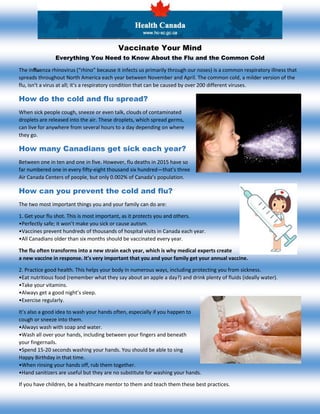
Fact Sheet
- 1. Vaccinate Your Mind Everything You Need to Know About the Flu and the Common Cold The influenza rhinovirus (“rhino” because it infects us primarily through our noses) is a common respiratory illness that spreads throughout North America each year between November and April. The common cold, a milder version of the flu, isn’t a virus at all; it’s a respiratory condition that can be caused by over 200 different viruses. How do the cold and flu spread? When sick people cough, sneeze or even talk, clouds of contaminated droplets are released into the air. These droplets, which spread germs, can live for anywhere from several hours to a day depending on where they go. How many Canadians get sick each year? Between one in ten and one in five. However, flu deaths in 2015 have so far numbered one in every fifty-eight thousand six hundred—that’s three Air Canada Centers of people, but only 0.002% of Canada’s population. How can you prevent the cold and flu? The two most important things you and your family can do are: 1. Get your flu shot. This is most important, as it protects you and others. •Perfectly safe; it won’t make you sick or cause autism. •Vaccines prevent hundreds of thousands of hospital visits in Canada each year. •All Canadians older than six months should be vaccinated every year. The flu often transforms into a new strain each year, which is why medical experts create a new vaccine in response. It’s very important that you and your family get your annual vaccine. 2. Practice good health. This helps your body in numerous ways, including protecting you from sickness. •Eat nutritious food (remember what they say about an apple a day?) and drink plenty of fluids (ideally water). •Take your vitamins. •Always get a good night’s sleep. •Exercise regularly. It’s also a good idea to wash your hands often, especially if you happen to cough or sneeze into them. •Always wash with soap and water. •Wash all over your hands, including between your fingers and beneath your fingernails. •Spend 15-20 seconds washing your hands. You should be able to sing Happy Birthday in that time. •When rinsing your hands off, rub them together. •Hand sanitizers are useful but they are no substitute for washing your hands. If you have children, be a healthcare mentor to them and teach them these best practices.
- 2. What are the cold and flu symptoms? The symptoms of the flu are as follows, and often become severe: •High fever (39 degrees Celsius and above) •Chills •Body pains, including head and muscle aches and chest pains •Fatigue •Coughing and sneezing •Stuffed or runny nose •Runny eyes •Vomiting and/or diarrhea (this is more common in children than adults) Children can also experience some unique flu symptoms: convulsions, ear aches and stomach aches. The common cold has many of the same symptoms as the flu but they are nowhere near as severe or frequent in appearance. What should you do if you have a cold or the flu? If you or a member of your family belong to a high-risk medical group (children under five, the elderly, pregnant women, people with underlying health conditions and people with weakened immune systems) and you develop flu symptoms, call your doctor immediately for instructions. Otherwise, just stay home. Follow the steps on the previous page for healthy living and washing your hands, and make sure to get as much sleep as you can. Try your best to cough or sneeze into a tissue or your sleeve. This greatly reduces the spread of the flu because most of the discharge immediately sticks to a surface rather than spreading into the air. If you use a tissue, throw it in the trash immediately. Call your doctor if you don’t start feeling better after a few days or your symptoms get worse. If at any point your child experiences any of the following, seek medical attention immediately: •Fast breathing •Difficulty breathing •Drowsiness so severe that they have difficulty waking up •Severe crankiness/irritation or not wanting to be held •Dehydration, as exhibited by not drinking enough and not going to the bathroom enough For more information on the flu, talk to your health care provider or visit: www.healthycanadians.gc.ca/flu Nicholas Elliott, RN, Health Canada. elliottn@hc-sc.gc.ca 905-829-5555 x 135
